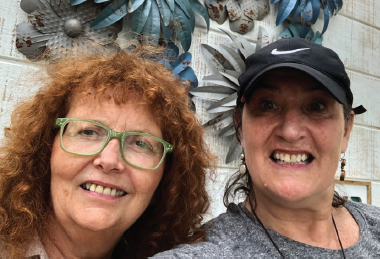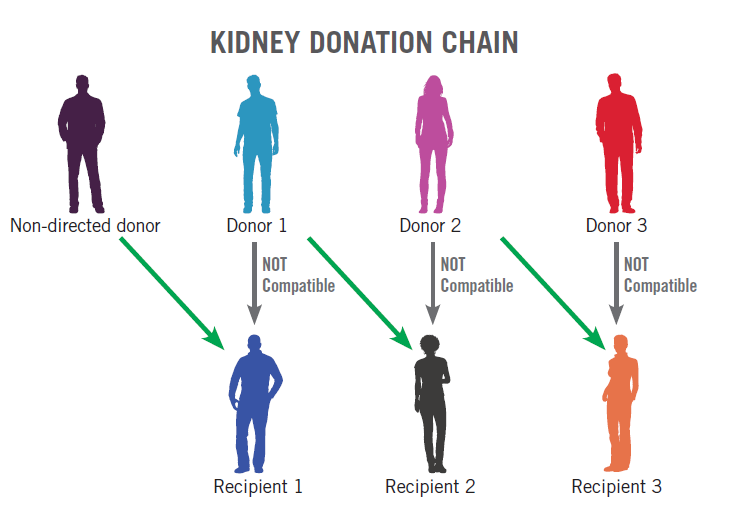Her donation was the start of a chain of kidney donations the led to three patients receiving life-saving kidney donations.
Jane Ehlers was first introduced to the idea of living donor kidney donation while in nursing school at Rutgers University. A week after graduating, Jane donated her kidney to a recipient in need. Her donation was the start of a chain of kidney donations the led to three patients receiving life-saving kidney donations.
What makes a person donate a kidney to a stranger?
For Jane Ehlers, a presentation by a guest speaker in one of her nursing school classes was a revelation. A representative from the NJ Sharing Network talked about the long wait time for a kidney transplant—the average is three to five years—and about living donors. Because a person can survive with just one kidney, someone with two healthy kidneys can choose to donate one of them.
“That really piqued my interest,” Jane recalls. “In my clinical studies, I had seen what people have to deal with when they’re on dialysis and waiting for a kidney. I thought it would be really cool if I could have that impact on someone.”
She began exploring the topic through the Living Donor Institute at the Renal and Pancreas Transplant Division at Cooperman Barnabas Medical Center (CBMC) in Livingston, one of the largest kidney transplant programs in the country. In 2019, one week after she graduated from Rutgers University with a nursing degree, she donated one of her kidneys.
Some people donate a kidney for a loved one or request that it be given to a specific type of person, such as a child. “I told them, give my kidney to whoever you think is fit, and try to help as many people as possible,” Jane recalls. Her donation started a chain that led to three patients receiving life-changing kidney donations.
Getting Ready
Most people who are waiting for a kidney transplant are on dialysis, a process that involves cleaning out waste products from the patient’s blood and returning the cleaned blood to the body. While lifesaving, dialysis can be a grueling procedure. “For the majority of patients, transplantation is better than dialysis for quality and duration of life,” says Francis Weng, MD, Chief of the Renal and Pancreas Transplant Division at CBMC.

A kidney transplant can be from a deceased donor or a living donor. “Based on results, receiving a kidney from a living donor is clearly preferable. They almost always work right away and last longer,” says Dr. Weng. The majority of transplants are from deceased donors, but the number of living kidney donors is steadily rising.
To hear Jane tell it, the process of donating a kidney was straightforward. She met with multiple members of the living donor team, including a physician, nurse and social worker, to make sure she was fully educated and all her questions were answered. She then underwent testing and evaluations to make sure that she was mentally and physically a good candidate to donate her kidney. “There were so many tests, I was almost rolling my eyes,” Jane says. “But it did make me feel safe.” She talked to the doctors about living a healthy lifestyle, taking certain precautions and having tests later in life to ensure that she would continue to be healthy with one kidney.
“Once you get over the fact that you’re having major surgery, it gets easier to do,” Jane says. “You realize how profoundly safe it is and how important it is for the person who will get your kidney.”
The operation was done through a laparoscopic (minimally invasive) procedure that required only small incisions. Jane left the hospital the next day and was able to resume most normal activities within a week. Though the pandemic has delayed plans for her to meet her kidney recipient, she has heard that the patient is doing very well.
The experience was life-changing in more ways than one.
When Jane was awaiting her procedure, a pre-op nurse in the CBMC transplant department took her hand and said, “I know this is really nerve-wracking for you, but we do this every single day and we take care of everyone like we would our family.”
The nurse’s words stuck with Jane. This was the kind of nursing care she wanted to provide in her own career. Jane Ehlers, RN, even worked on a renal and pancreas transplant unit at CBMC after college. When any of her transplant patients needed her help, she was there for them.
A Friend in Need

Brenda Ehlers, 59, at right, is the mother of Jane Ehlers. Shortly after Jane donated her kidney, Brenda learned that she was a compatible match for a dear family friend who had polycystic kidney disease and had taken a turn for the worse. In November 2020, she donated a kidney to her friend. “Nothing has changed in my life,” she says, “except now I get to hear about my friend traveling and being able to visit her granddaughter.”
How Do Kidney Paired And Altruistic Donations Work?
Often, a patient in need of a kidney transplant (recipient) comes to Cooperman Barnabas Medical Center with a kidney donor, only to discover that the recipient/donor pair is incompatible by blood type or cross-matching.
In such cases, the Kidney Paired Donation Program increases the ability of potential kidney transplant recipients to receive kidney donations from living donors. The program involves the matching and exchange of kidneys between parties so that all donors donate and all recipients receive a compatible kidney transplant.
Altruistic donors (also known as non-directed donors) are individuals who come forward to donate their kidney but do not identify a specific recipient. Non-directed donors may choose to participate in a kidney paired donation and start a chain of transplants. These transplant chains can connect many pairs and save many lives.

Learn more about living kidney donation at Cooperman Barnabas Medical Center.
To register as an organ and tissue donor, please visit: www.registerme.org/cbmc.